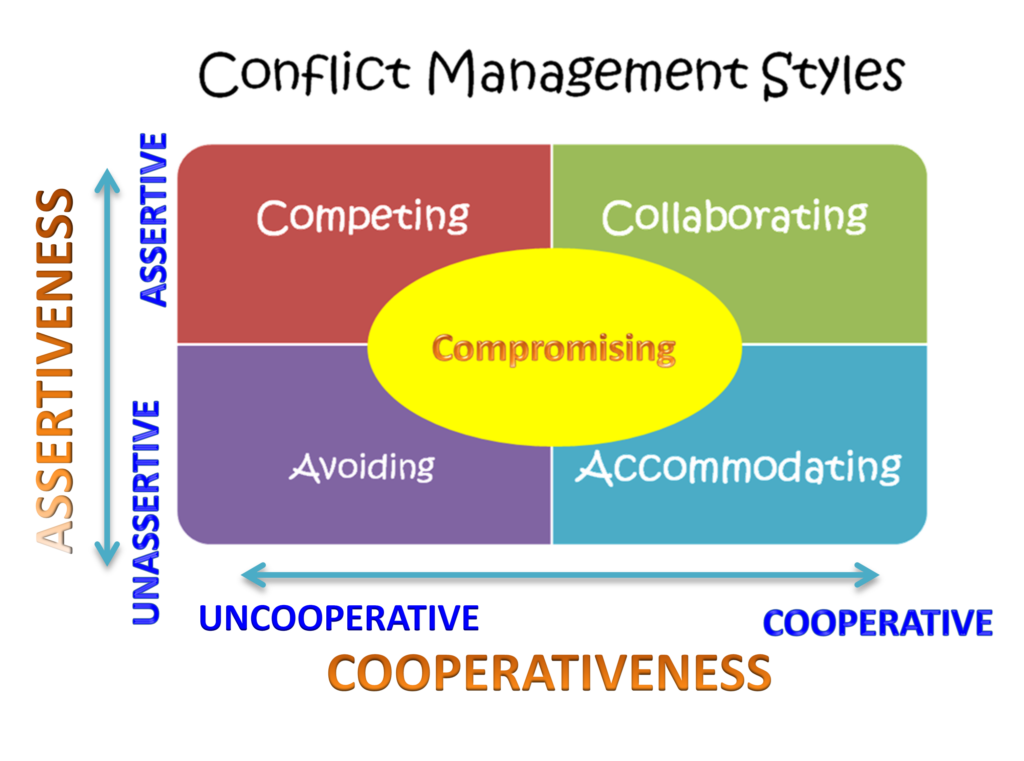Thomas-Kilmann Conflict Mode Instrument (TKI)
When two people are attempting to resolve a conflict, their individual behaviours can be described in terms of the levels of assertiveness and cooperativeness they express. Assertiveness measures the degree to which they attempt to satisfy their own concerns. It describes how they value the task and how they work to make their point clear. Cooperativeness describes the level to which they attempt to satisfy the other’s concerns. It measures how they value their relationships with each other. Plotting each person’s relative levels of assertiveness and cooperativeness on a coordinate system identifies five regions (Thomas & Kilmann, 1974) with the personal characteristics shown in Figure 1.
Figure 1. Conflict management styles
These conflict management styles are described as.
Competing
- “I value the point being made more than our relationship.”
- “It’s them or me.”
- “I’ve got to win this one!”
- “I’m sure they will see it my way if they just think about it.”
- “I know I’m right.”
This is the “I win, you lose” position. A person whose actions are expressed this way is sometimes symbolized as a Lion. A lion know what it wants and does not let anything get in the way.
Collaborating
- “I’m sure if we work together we can come up with a better answer than either of us individually.”
- “I’m not giving in yet, but I am willing to hear your opinion, and give you mine.”
This is the “I win, you win” position. A person whose actions are expressed this way is sometimes symbolized as an Owl. An owl sees everything and knows when to make the best move.
Avoiding
- “I will be quiet and listen.”
- “It’s not that big a deal.”
- “I’d rather just forget it.”
- “It’s not worth the trouble.”
- “What difference could I make anyway?”
This is the “I lose, you lose” position. A person whose actions are expressed this way is sometimes symbolized as a Snail. A snail move so slowly hoping someone else will do the job.
Accommodating
- “I value our relationship more than this point.”
- “Let’s just get this over with so we can get on to other things.”
- “This tension is very uncomfortable. I’ll just do what they want.”
- “Fine I give in, have it your way.”
This is the “I lose, you win” position. A person whose actions are expressed this way is sometimes symbolized as a Rabbit. Like a rabbit stuck in the head lights of a car.
Compromising
- “This isn’t important enough to fight over.”
- “I don’t want to be unreasonable.”
- “Give something to get something.”
This is the “We could both live with that” position. A person whose actions are expressed this way is sometimes symbolized as a Fox. Not a dominant style but one that can be adopted to help work with other styles, cunning.
People tend to use one of the first four conflict styles. The fifth style, compromising, describes a state that can be used temporarily to get someone to move from one of the other styles. For example, if the person is acting like a shark you can help him/her to become less assertive and more cooperative. If he/she is acting like a teddy bear you can help him/her to become more assertive and a little less cooperative. Some people make careers around their abilities to help people move from a preferred corner of Figure 1 to some other position in the figure.
This simple model represents choices people or teams make when they resolve conflicts. Depending on the situation, each can prove to be valuable. They need not be fixed reflections of personalities, education, or position in the organization. Every step of the way the people involved have choices about how they act.
Information adapted from University of Arizona website
Prepared by Hugh McLain
Bibliography
Thomas, K. W., & Kilmann, R. H. (1974). The Thomas-Kilmann Conflict Mode Instrument. NY: XICOM, Inc.
